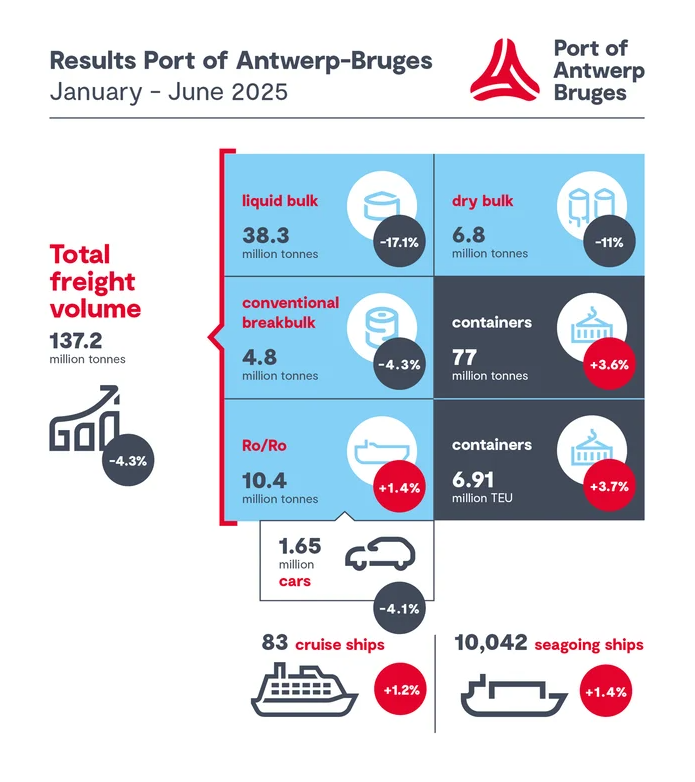Container Growth cushions impact of bulk traffic decline and congestion at port of Antwerp-Bruges

In the first half of 2025, the Port of Antwerp-Bruges handled a total throughput of 137.2 million tonnes, representing a 4.3% decline compared to the same period in 2024.
Despite this overall drop, strong performance in container and RoRo traffic helped offset the decline in bulk cargo, while congestion and logistical challenges continued to strain operations across Northwest Europe.

Container traffic proved resilient, with volumes rising 3.6% in tonnage to 77 million tonnes, and 3.7% in TEUs to 6.91 million, year-on-year.
The port’s robust transatlantic trade, particularly with the United States, remained a key growth driver. However, persistent congestion at terminals has intensified pressure on infrastructure, underscoring a broader issue affecting major ports in the region.
The recent realignment of container shipping alliances has led to bunching of vessel calls and surges in cargo volumes. Schedule reliability remains low, with many ships arriving late and heavily loaded. As a result, average container dwell times have increased to 7–8 days, compared to the normal 5 days.
Overcrowded terminals now require extra container moves, stretching personnel and equipment. Additional strain has come from national union actions, which have further complicated day-to-day operations.
Meanwhile, liquid bulk throughput fell sharply by 17.1%, driven by declines in fuels, naphtha, and LNG, largely due to geopolitical tensions, EU sanctions, and market overcapacity.
In the general cargo segment, the impact was more moderate. Conventional general cargo dropped 4.3%, with the decline linked to weaker steel and iron imports.
A standout trend was the 17.2% increase in total trade with the United States, reaching 16.4 million tonnes, reaffirming the US as the port’s second largest trading partner after the UK, and confirming its status as Europe’s leading export port to the US.
Imports from the US rose by 13.1% to 9.7 million tonnes, with growth in both containers and liquid bulk, including LNG. Exports increased by 23.5% to 6.7 million tonnes, mainly fueled by dry bulk and energy products.
While container exports held steady at 303,000 TEUs, imports rose 12.6%, suggesting potential stockpiling or trade anticipation.
Looking ahead, the outlook for the second half of 2025 remains uncertain, hinging on the possible conclusion of a US-EU trade agreement by August 1st, which could bring renewed stability and predictability to transatlantic trade.
Jacques Vandermeiren, CEO of the Port of Antwerp-Bruges, stated that the growth in container traffic proves the strong foundations of Port of Antwerp-Bruges, even as bulk traffic comes under pressure and congestion is felt across North-West Europe. At the same time, he highlighted the the need for additional container infrastructure due to current capacity pressures and operational challenges.
![]()
The post Container Growth cushions impact of bulk traffic decline and congestion at port of Antwerp-Bruges appeared first on Container News.
Content Original Link:
" target="_blank">

































































